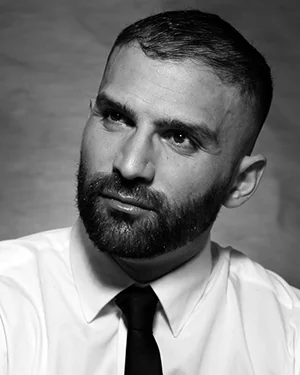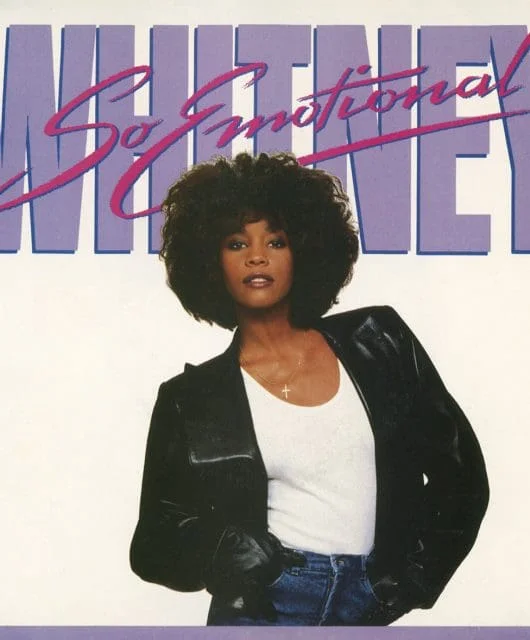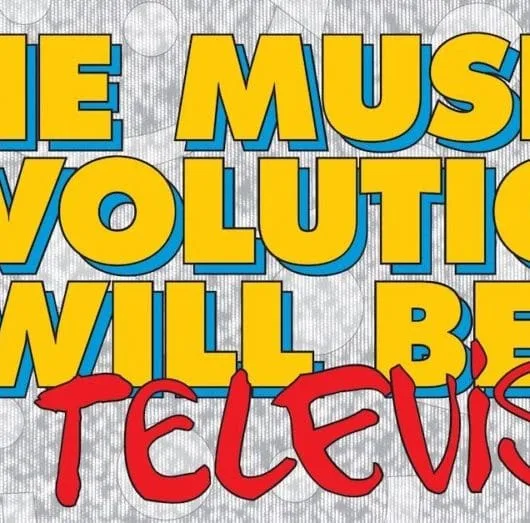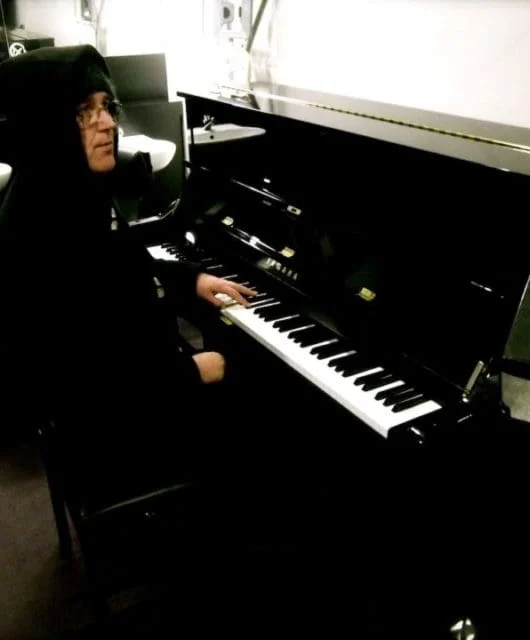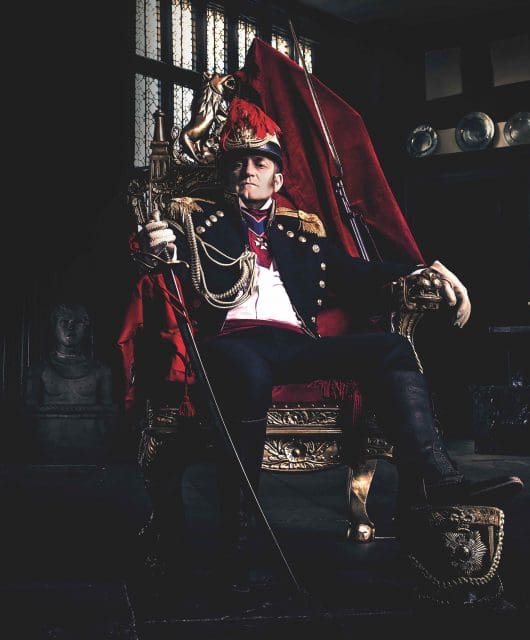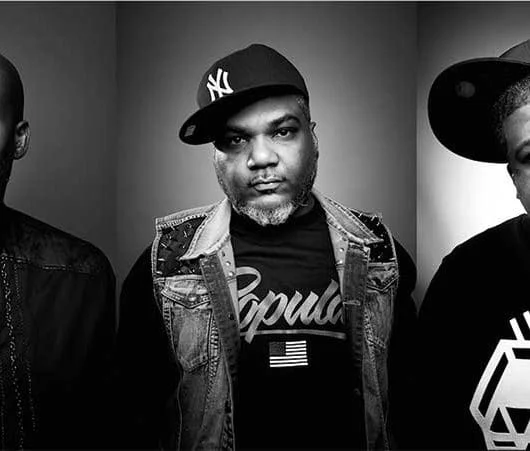Make It Big: The Story Of 1984
By Matthew Lindsay | September 2, 2024

The Story Of 1984: It was a year of decisive statements and feeding the world, of technological advances and solo beginnings. Amidst political tension, the Olympic Games and the LGBTQ+ community gaining a voice came a giant 12 months for pop…
On 8 January Paul McCartney’s Pipes Of Peace became the year’s first new chart-topper, replacing The Flying Pickets as the nation’s pop bibles flew off shelves. Howard Jones grinned on Number One’s cover, with clenched fist and a caption: “1984 comes out fighting”. Inside, pop stars predicted what 2020 would be like. On Smash Hits’ back, Paul Weller read Orwell’s Nineteen Eighty-Four: the future, it seemed, was already here.
Boy George and Annie Lennox confirmed it on US Newsweek’s cover – glamorous, androgynous, alien avatars of the second British Invasion. By February, Karma Chameleon sat atop the Billboard Hot 100, while Eurythmics’ Touch was Britain’s best-selling album.
Grammy audiences gasped at an Elvis-like Lennox, while George, receiving Culture Club’s Best New Artist award via satellite, told America they “knew a good drag queen when they saw one”. Amid the UK-supplied shock and awe, Michael Jackson snatched the most trophies, largely for ’82’s Thriller, still a US No.1, remaining there until mid-April.
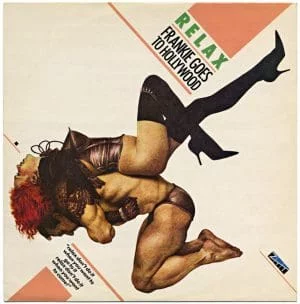
Tomorrow’s World
1984’s kaleidoscopic soundtrack would come from a pop explosion that was transatlantic, already flickering through the early UK Top 10. Here Comes The Rain Again, Fiction Factory’s (Feels Like) Heaven and China Crisis’ Wishful Thinking rubbed shoulders with Cyndi Lauper’s Girls Just Want To Have Fun and Rockwell’s Somebody’s Watching Me, Jacko-assisted paranoia in the year of Big Brother.
Talk Talk’s It’s My Life languished outside the Top 40, a harbinger of ’84’s injustice. But the title of Re-Flex’s The Politics Of Dancing, lurking in the Top 30, hinted at the serious fun ahead. Frankie Goes To Hollywood oozed it, obvious from the BBC-banned ‘obscene’ Relax, No.1 for five weeks, with added sonic orgasm from synth wizard Andy Richards’ Jupiter 8. Liverpool’s bad boys were unstoppable. Two Tribes held the top spot for nine weeks. Cinemascope heartstring-tugger The Power Of Love managed just a week in early December, before Band Aid captured the nation. Welcome To The Pleasuredome (No.1) sold at record-breaking speed and remained in the charts for over a year.
Frankie were a lethal combination – gay/straight northern chutzpah, punk provocation and disco liberation, the Pistols meets Boys Town Gang in Trevor Horn’s hi-tech world. Their future funk had prog-like heft especially on the multiple mixes that were drip-fed to record buyers, keeping sales high. Paul Morley stoked the hype machine, the NME journo-turned-ZTT arch-conceptualist emblazoning T-shirts with ‘Frankie Says’ slogans, while ads and record sleeves were pure post-punk pop art. Videos courted outrage. Relax was a genuine jaw-dropper, Fellini-esque decadence, gay sex club sauciness, and a tiger. Two Tribes featured Reagan vs Chernenko wrestle-mania and the end of the world. “It’s 1984, people can handle it,” Paul Rutherford told Number One, adding that Frankie’s label ZTT also “like to play the game dangerously.”

Frankie Say Relax
Armed with Morley’s ideas, Jill Sinclair’s business acumen and husband Horn’s maximal productions, ZTT balanced hits with innovation. Released in February, Propaganda’s Dr Mabuse was, Number One gushed, “pure drama… simply monstrous… ABBA in hell.” Horn arrayed himself with a stellar team, including the Art Of Noise collective: engineer Gary Langan, composer Anne Dudley and programmer J.J. Jeczalik. June’s Who’s Afraid…? was a cut-and-paste collage of classical, hip-hop, industrial and electronic sound, a mid-80s Kraftwerk with Fairlight samplers, sequencers and drum machines. October’s Close (To The Edit) took musique concrète onto the dancefloor and into the Top 10.
All involved were in-demand. Horn topped the Billboard Hot 100 with Yes’ Owner Of A Lonely Heart, and was eyeballed by Sylvester and Madonna. Jeczalik sprinkled Fairlight fairy dust all over Billy Idol’s Flesh For Fantasy and Scritti Politti’s Absolute. The Fairlight ruled ’84, its magically ‘vocal’ ARR1 setting gliding through Art Of Noise’s Moments In Love and the ZTT-less Shout by Tears For Fears. Dudley composed for Five Star and added electric piano-like sparkle on a Yamaha DX7 to George Michael’s Careless Whisper (ZTT’s Andy Richards supplied choral caress, sampling Michael’s voice on a PPG Waveform A).

You Should Be Dancing
Pop was pushing itself to extremes, possibilities seemed endless, and often chart-bound. Nile Rodgers’ manically hip-hop-stuttering remix of Duran Duran’s The Reflex was a transatlantic No.1. Paul Young’s I’m Gonna Tear Your Playhouse Down came with industrial-strength overload, further intensified on the 12″. Malcolm McLaren’s Madame Butterfly, a UK No.13, blended Puccini with ultra-modern R&B. 1984’s pop was forever moulding itself into new forms (see Eurythmics and Howard Jones’ remix albums). Number One readers were too, creating new posters from existing ones: Suggs’ hair, Boy George’s face, George Michael’s body.
Relax’s mechanised throb echoed sounds spilling out from gay dancefloors into ’84’s charts, inspiring High Energy’s titular anthem, a No.5 summer smash for Evelyn Thomas. This was disco’s adrenalised machine-made update (DJ-producer Ian Levine’s nods to Village People). Sweaty, gay nightclub drama also fuelled Hazell Dean’s Searchin’ (No.6), recreated on May’s TOTP performance, lights frantically flashing to bum-bouncing bass and Dean hollering: “I gotta find me a man!” Follow-up Whatever I Do (Wherever I Go) came from Stock Aitken Waterman, who’d produced You Think You’re A Man (No.15) for drag queen Divine. Dead Or Alive’s Pete Burns took notice, called SAW and by November, You Spin Me Round (Like A Record) was out.

Reclaiming The Pink Triangle
From The Weather Girls’ No.2-charting It’s Raining Men to Gloria Gaynor’s I Am What I Am to Laura Branigan’s Self Control (No.5), the charts had never seemed gayer. Holly Johnson made No.1s from homo-desire’s two extremes (The Power Of Love’s religious romance, Relax’s priapic lust). “Cheap, disgusting and very childish,” said Boy George in Record Mirror, secretly threatened as Frankie flaunted what he’d kept coyly contained in a tea-drinking doll persona.
Bronski Beat made George feel lightweight too, they’re out, loud and proud political edge served in dressed-down normality (gays “pay rates and go to the cinema,” said Jimmy Somerville). Smalltown Boy, it sleeve brandishing a pink triangle, took gay adolescent escape to No.3, Somerville’s falsetto “whistling like a train” to wistful hi-NRG. The moral fury was relentless – Why? (No.6) was “fighting for our love”, The Age of Consent (UK No.4) addressed gay sex law inequality.

Let’s Get Political
Meanwhile, Soft Cell imploded heroically with March’s This Last Night In Sodom: sonically dense, recorded partly in mono, a multi-tracked vortex of murder songs and madness. Marc Almond returned, solo and Scott Walker-style, for You Have, The Boy Who Came Back and Tenderness Is A Weakness; pure strings-soaked melodrama. There were more grim lives under bright lights on the original West End Girls by Pet Shop Boys.
Still at Smash Hits, Neil Tennant rave reviewed Sylvester’s Rock The Box, fierce electro from a disco veteran (for more gay America ’84 style see Jermaine Stewart’s The Word Is Out and David Lasley’s Raindance). In Number One, Sylvester mentioned AIDS, the disease annihilating the gay community in increasingly large numbers. Fear, anger and denial swept through US cities as the UK moved to a hedonistic gay beat. Bleakly prophetic, Freddie Mercury’s debut solo 45 that year was called Love Kills.
In June, as Smalltown Boy appeared, the LGSM (Lesbians And Gays Support The Miners) was formed. Unlikely alliances were forged in politically charged times, as Thatcher’s government clashed with communities facing pit closures. “Perverts Support The Pits” screamed one headline, repurposed as ‘Pits And Perverts’ for Bronski Beat’s miners’ benefit that December, following New Order’s in May and an all-star September fundraiser featuring Wham! and The Style Council. Others were more sceptical, reflecting a conflict within British pop between personal ambition and social awareness.
As Thatcher’s ’83 victory sank in, big issues hit the charts, from anti-apartheid (Special AKA’s Free Nelson Mandela) to the Irish Troubles (Bananarama’s Rough Justice). Post-Falklands, a cold war looming, apocalypse was a hot topic, Two Tribes and Nena’s 99 Red Balloons took the threat of nuclear annihilation to No.1, Strawberry Switchblade’s Since Yesterday took it to No.5.

Shout To The Top!
1984’s topicality was matched by deep silliness. The Young Ones toppled TOTP as Smash Hits readers’ favourite show, Neil’s Hole In My Shoe went Top 10.
Then there was Black Lace’s Agadoo, a No.2 knees-up for inebriated, horny holidaymakers everywhere (Duty Free debuted on TV that February). Misty-eyed pop nostalgists note, their Party Party outsold Spandau’s Parade. While some wore their politics lightly (Tracey Ullman’s comic My Guy video co-starred Neil Kinnock), Boy George thought Paul Weller’s idealism needed glam-coating (“fake fur and politics do mix!”). But The Style Council’s Shout To The Top! (No.7) proved how life-affirming and uplifting resistance could be.
Café Bleu, released in March, was impeccably hip; from its vintage Euro-cool cover to its largely retro soul-jazz tracks. Top 10s My Ever Changing Moods and You’re The Best Thing, joined The Paris Match, sung by Tracey Thorn. That summer Everything But The Girl’s Eden arrived with bossa nova heartbreak classic Each And Every One, which like Carmel’s The Drum Is Everything harked back with evocative fidelity to a bygone era.
A jazz revival was in full swing with a photogenic superstar, Nigerian-born, Essex-raised Sade Adu. Diamond Life, one of ‘84’s top sellers, added contemporary, style-bible polish. Others were more danceable (Animal Nightlife’s Mr Solitaire) or poppy (Matt Bianco), even gothic (Swans Way’s Top 20 Soul Train). Cynics scoffed that Sade was ersatz jazz for wine-bar yuppies. But Your Love Is King and Smooth Operator breezed luxuriantly through a troubled year, full of sensuous, romantic promise. The Blow Monkeys’ Atomic Lullaby played with that tension – sax-soaked swoon interrupted by a nuclear explosion.

Tribal Gatherings
In October, the paranoid, unstable mood deepened with the IRA’s Brighton bombing, and a ferocious new Duran Duran 45, The Wild Boys (No.2) co-produced by Nile Rodgers. Simon Le Bon told Number One, it was about society breaking apart: “I don’t want people eating each other.”
Another release was the Eurythmics’ Sexcrime; more high-voltage and high tension. In the year of Orwell’s dystopia, their music for the film adaptation was dark, electronic, experimental. Something atavistic was charging through ’84’s hi-tech pop, full of giant, chanting, tribal battle cries (Adam Ant returned with the No.13-charting Apollo 9). There were rebel yells and warrior women. Kim Wilde was remade as a Barbarella vamp, Duran as Mad Maxes – Olympic ambition in an Olympic year.
Rock was sharpening pop’s edges – The Wild Boys, The Human League’s anti-war The Lebanon and Bucks Fizz’s No.15 Talking In Your Sleep (Le Bon’s ’84 pick was The Psychedelic Furs’ Mirror Moves). January’s Learning To Crawl by The Pretenders set the tone for a tough, muscular ’84, heard on three No.1 albums, Big Country’s Steeltown, U2’s The Unforgettable Fire and Simple Minds’ Sparkle In The Rain.

What We Do In The Shadows
Alternative music offered a smart antidote to aspirational blockbuster pop, with The Smiths and Lloyd Cole And The Commotions’ Rattlesnakes in the UK and R.E.M’s Reckoning in the US. A modern psychedelia was afoot, hugely popular on Echo & The Bunnymen’s Ocean Rain, exotically goth on The Cure’s The Top and Siouxsie And The Banshees’ Hyæna. Cocteau Twins’ Treasure similarly retreated into saturated textures and netherworlds, away from the 80s moment.
For most, though, it was inescapable. A perfect sign of the inter-connected times was the dawn of MIDI; sync’d up, digital machine-tooled precision. Pop was now operating in an expansive, hyper-visual universe, where tech blended with real instruments, mingling with genres, crossing racial boundaries and generations. Britain’s 1984 motley crew sprang from this synergy, from Nik Kershaw (muso-made star with snood, synthesizers and FX-heavy videos) to Thompson Twins (post-punk also-rans turned transatlantic MTV-friendly sensation).
This synergy defined ’84’s US pop explosion too. Prince’s mega-selling Purple Rain came with a movie and synthesized futuristic funk/soul, New Wave pop and rock. Reviewing Prince’s When Doves Cry, 1984’s biggest US 45, John Taylor commented on how heavy pop was getting. Cyndi Lauper seamlessly wove styles (and a Prince cover) into She’s So Unusual. UK punk-turned-US star Billy Idol shifted Prince-like gears on Eyes Without A Face, from soft-core synth-pop to nut-nodding rock.

Video Killed The Radio Star
Older stars adapted, embracing synths, remixes and videos, from Springsteen’s Born In The USA to Tina Turner’s Private Dancer. British legacy acts Queen (The Works) and Rod Stewart (Camouflage) did likewise. Everything was pop-powered, synth-propelled and video-ready, including hard rock – British record buyers made ’83’s Eliminator by ZZ Top a bestseller, while Van Halen’s Oberheim-powered Jump was an MTV Award-winning US No.1.
Held on 14 September, the MTV Video Music Awards reflected how post-Thriller America had been deploying the British Invasion’s tactics. Madonna stole the show at Radio City Music Hall, baring her knickers in a wedding dress. At August’s New Music Seminar, John Oates questioned video’s increasing power, as Madonna defended it.
By December, Like A Virgin, with its Venice-shot, Mary Lambert-directed promo, was a US No.1, dislodging Hall And Oates’ Out Of Touch. In the UK, where hits from ’83’s Madonna (Holiday, Lucky Star, Borderline) trickled into ’84’s charts, it hit No.3. Brit-friendly poses were struck, radiating C&A Clockhouse model energy in Smash Hits, cavorting across TOTP’s stage in a pink wig, positioning her for ’85’s takeover.

Rise Of The Machines
Amid this transatlantic, muscular hybridisation, many synth-pop pioneers struggled. The Human League’s Hysteria was, 45s aside, a major disappointment, while classy reinventions (Associates, Thomas Leer, DAF’s Robert Görl) and new acts (Messengers) evaded record buyers. Others thrived – Howard Jones (Human’s Lib) and Blancmange (Mange Tout), while OMD bounced back with Junk Culture and Top 10 earworm, Locomotion.
As Mute’s Fad Gadget released swansong masterpiece Gag, labelmates Depeche Mode emerged as synth-pop stalwarts, adding anti-bigotry anthems (People Are People) and perv-pop (Master And Servant) to the sample-heavy experimentation. Equally bold was Gore’s kinky clobber, centre-stage on Smash Hits’ November cover.
Some Great Reward was recorded in Germany where People Are People hit No.1. Synths, like jazz, were used, to varying degrees on the year’s exquisite art pop; Talk Talk’s It’s My Life, David Sylvian’s Brilliant Trees, Thomas Dolby’s The Flat Earth and The Blue Nile’s A Walk Across The Rooftops.

Everything Must Change
On the giddy carousel of ’84 pop, Madness held on with Keep Moving (No.6), boasting cheeky samples of the titular actor on Michael Caine (No.11). But grown-up melancholy characterised one of the year’s finest, tackling homelessness on One Better Day; Kinks-style social commentary with ’84-style sax. However, anyone could get lost in ‘84’s frenzy. “I don’t fit in,” sang Kim Wilde on Teases & Dares, sporadic gems obscured by Kim’s ‘supervixen’ makeover. Bananarama, remained ‘flatmates next door’ – relatable, and Robert De Niro’s Waiting, another ace ode to a cult actor, hit No.3.
Their producers Jolley/Swain helped make Alison Moyet the non-Sade female voice of ’84. Alf dialled down Yazoo’s future shock, synths delicately placed on All Cried Out and Love Resurrection’s blue-eyed Top 10 soul (Motown legend Lamont Dozier penned the No.21-charting Invisible). The soulful, sophisticated pop of the 80s’ second half was moving closer, also hinted at on Paul Young’s Everything Must Change and The Kane Gang’s Closest Thing To Heaven.

British Invasion
Pop’s premier league ruled ’84 with a mix of imperial pomp and unease. Duran Duran’s transatlantic supremacy reached Beatles-esque proportions. Hot on their heels were Wham! Mega-selling, Motown updates (Wake Me Up Before You Go-Go, Freedom) were offset by Everything She Wants’ deep-electro-soul. The dynamic duo seemed inseparable but ’84 teased George Michael’s solo future. Number One called him a “one-man girl group”. Careless Whisper tipped the balance further, outselling Wham!’s mega-45s. Male self–lacerating soul-baring was big in ’84, from Jim Diamond’s No.1 I Should Have Known Better to Phil Collins’ Against All Odds (US 1, UK 2) to John Waite’s Missing You.
The sax-packed smooch factor was high on Spandau Ballet’s Parade too, with added rock swagger, Gary Kemp’s guitar cruising like a Jaguar. Videos came with slick confidence – Only When You Leave nodded to Hitchcock, I’ll Fly For You took them to New Orleans, Highly Strung to Hong Kong. These jet-setting sagas were pure 80s bombast, with hovering helicopters and Martin Kemp rolling around naked with a model. Martin appeared in Smash Hits, suited with shoes sans socks, like Crockett in Miami Vice, 1984’s new US show, MTV-indebted with its constant pop soundtrack and rapid fire editing.

Glitz & Gloss
Culture Club seemed trapped in a glitzy soap opera, one oscillating between triumph and catastrophe. Boy George was inescapable – in magazines, Wogan, Letterman, Johnny Carson. Feuds were constant – Holly Johnson, Princess Margaret, Pete Burns, his secret lover Jon Moss, and seemingly all of Fleet Street. Emotions were mixed, costumes ever-changing. He was ‘done’ with Marilyn; then they were pictured in Number One magazine, holidaying together in Jamaica.
September’s The War Song was an anti-war protest from someone seemingly fighting with everyone. Midway through, the incongruous Caribbean-style singalong was engulfed by haunting horror – furious chants, Clare Torry’s anguished wailing, a ‘bereaved bride’, updating her star turn on Pink Floyd’s The Great Gig In The Sky, while George hovered, spooky as a soldier’s ghost. From social concern leapt personal crisis – “Won’t somebody help me?” Both silly and profound, it could be 1984’s key single, dramatising conflict inside and out.
Such thrilling tension was scarce on Waking Up With The House On Fire, cobbled together in three weeks, the garish sleeve and George’s new red hairdo covering a multitude of pop sins (Mistake No.3 aside). Culture Club, like The Human League, weren’t alone in delivering duds. The Jacksons’ Victory was more filler than Thriller, David Bowie’s Tonight promised much: a Tretchikoff meets Gilbert & George sleeve, rollicking lead single, Blue Jean, and wondrous opener Loving The Alien. But beyond Tumble And Twirl, it was covers-heavy padding. The grand 80s folly had arrived, lavishly packaged, recorded in luxury studios, mediocrity lurking amid hits and high-gloss.

Hit Me With Your Best Shot
In a fiercely competitive world, Boy George wasn’t the only scrapper; claws were out in ’84 – George Michael had beef with Alphaville’s Big In Japan and Nena (“‘99 red ballons my arse’”). In Smash Hits, Midge Ure trashed Duran’s The Wild Boys (“pathetic!”), Wham! (“debauched!”), even U2 (“boring!”). Soon he’d be in Sarm West with all of them, and more, recording Do They Know It’s Christmas?, co-written with Bob Geldof, who’d masterminded the event, horrified by an Ethiopian famine news report he’d seen that October, herding pop stars like cats, the common cause calming egos.
The Yuletide competition also overflowed with community spirit: Paul McCartney’s The Frog Chorus, Slade’s All Join Hands, Paul Weller’s Council Collective, with Soul Deep’s proceeds going to miners’ families. However, Band Aid beat them all, the festive chart-topper seeing off Wham!’s Last Christmas, too. Geldof had begun ’84 as Wally Of The Week in January’s Melody Maker. He ended it a national hero in a divided nation. Boy George, January’s darling, found himself over-exposed, voted ‘prat’ (Smash Hits) and ‘wally’ (Number One) of ’84 by readers.
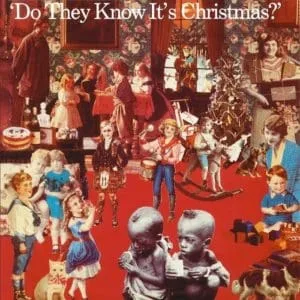
Bigger The Better
Despite many fine albums, 1984’s glories really spun at 45rpm, not 33rpm, gathered on mega-selling compilations, Now… and The Hits Album, recorded onto those blank tapes, heavily advertised in the pop mags. Cassette sales eclipsed vinyl’s that year, while CDs were an ever-growing threat. Some even saw the digital future. Vince Clarke predicted music’s 2020 format would be the micro-chip, Quincy Jones saw it coming from “a vast catalogue in the sky”. Simple Minds told us the New Gold Dream was 81-82-83-84. But what then?
Throughout 84’s blockbuster racket, there’s instant nostalgia, as if Steve Gregory’s sax on Careless Whisper, Since Yesterday and Life On Your Own knew a door was forever closing on the 80s’ magical first half. But ’85 was already forming on record shelves in 1984 – Prefab Sprout’s When Love Breaks Down, Scritti Politti’s immaculate singles.
1984 really was a peak. Everything came supersized – mullets, Tony Hadley’s leather jacket, the suit on Talking Heads’ Stop Making Sense, visual shorthand for stockbrokers. Or, as Holly Johnson put it, “Yuppies. Which is what we are. People trying to make it on a bigger level.” 1984’s pop was full of those – big egos, big ideas and a big, beating heart.
Enjoy this article? Check out our Top 40 80s pop artists
